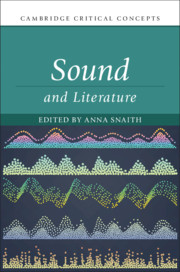38 results
21 - Noise: Labour, Industry and Embodiment in Interwar Factory Fiction
-
-
- Book:
- The Edinburgh Companion to Modernism and Technology
- Published by:
- Edinburgh University Press
- Published online:
- 07 June 2023
- Print publication:
- 30 September 2022, pp 328-342
-
- Chapter
- Export citation
Contributors
-
- Book:
- Sound and Literature
- Published online:
- 29 May 2020
- Print publication:
- 18 June 2020, pp xii-xv
-
- Chapter
- Export citation
Figures
-
- Book:
- Sound and Literature
- Published online:
- 29 May 2020
- Print publication:
- 18 June 2020, pp xi-xi
-
- Chapter
- Export citation
Contents
-
- Book:
- Sound and Literature
- Published online:
- 29 May 2020
- Print publication:
- 18 June 2020, pp ix-x
-
- Chapter
- Export citation
Part II - Development
-
- Book:
- Sound and Literature
- Published online:
- 29 May 2020
- Print publication:
- 18 June 2020, pp 133-208
-
- Chapter
- Export citation
Bibliography
-
- Book:
- Sound and Literature
- Published online:
- 29 May 2020
- Print publication:
- 18 June 2020, pp 389-420
-
- Chapter
- Export citation
Copyright page
-
- Book:
- Sound and Literature
- Published online:
- 29 May 2020
- Print publication:
- 18 June 2020, pp vi-vi
-
- Chapter
- Export citation
Introduction
-
-
- Book:
- Sound and Literature
- Published online:
- 29 May 2020
- Print publication:
- 18 June 2020, pp 1-34
-
- Chapter
- Export citation
Part III - Applications
-
- Book:
- Sound and Literature
- Published online:
- 29 May 2020
- Print publication:
- 18 June 2020, pp 209-388
-
- Chapter
- Export citation
Epigraph
-
- Book:
- Sound and Literature
- Published online:
- 29 May 2020
- Print publication:
- 18 June 2020, pp vii-viii
-
- Chapter
- Export citation
Acknowledgements
-
- Book:
- Sound and Literature
- Published online:
- 29 May 2020
- Print publication:
- 18 June 2020, pp xvi-xvi
-
- Chapter
- Export citation
Index
-
- Book:
- Sound and Literature
- Published online:
- 29 May 2020
- Print publication:
- 18 June 2020, pp 421-424
-
- Chapter
- Export citation
Part I - Origins
-
- Book:
- Sound and Literature
- Published online:
- 29 May 2020
- Print publication:
- 18 June 2020, pp 35-132
-
- Chapter
- Export citation

Sound and Literature
-
- Published online:
- 29 May 2020
- Print publication:
- 18 June 2020
7 - Mobile Modernisms
- from (I) - Global Locals
-
-
- Book:
- The Cambridge History of Black and Asian British Writing
- Published online:
- 19 December 2019
- Print publication:
- 16 January 2020, pp 116-131
-
- Chapter
- Export citation
Introduction
-
- Book:
- Modernist Voyages
- Published online:
- 05 February 2014
- Print publication:
- 24 February 2014, pp 1-35
-
- Chapter
- Export citation
Notes
-
- Book:
- Modernist Voyages
- Published online:
- 05 February 2014
- Print publication:
- 24 February 2014, pp 207-254
-
- Chapter
- Export citation
Bibliography
-
- Book:
- Modernist Voyages
- Published online:
- 05 February 2014
- Print publication:
- 24 February 2014, pp 255-274
-
- Chapter
- Export citation
Chapter Two - Sarojini Naidu: Feminist Nationalism and Cross-Cultural Poetics
-
- Book:
- Modernist Voyages
- Published online:
- 05 February 2014
- Print publication:
- 24 February 2014, pp 67-89
-
- Chapter
- Export citation
Chapter Six - Una Marson: ‘Little Brown Girl’ in a ‘White, White City’
-
- Book:
- Modernist Voyages
- Published online:
- 05 February 2014
- Print publication:
- 24 February 2014, pp 152-174
-
- Chapter
- Export citation



